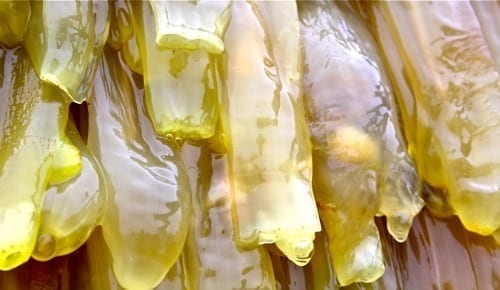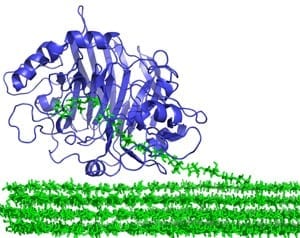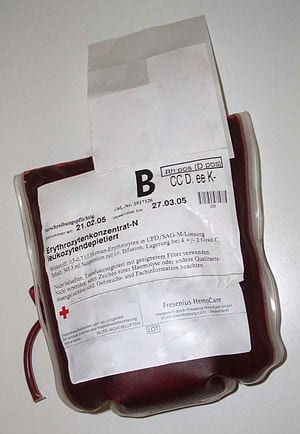
It sounds too good to be true: a common marine species that consumes microorganisms and can be converted into much-needed feed for salmon or a combustible biofuel for filling petrol tanks.
And it can be cultivated in vast amounts: 200 kg per square metre of ocean surface area.
Tunicates (ciona intestinalis) is the name of this unexpected source of such rich potential. The species is the starting point for a research-based innovation project being carried out by researchers and innovation specialists in Bergen. The idea was hatched by a group of researchers at the University of Bergen and Uni Research.
Produces cellulose and contains omega-3
The yellowish, slimy growth that many of us have come across on ropes that have lain in seawater is the marine organism known as tunicates.
Tunicates are basically living filter tubes that suck bacteria and other microorganisms into one end and excrete purified water out the other end. This is how tunicates feed – at the very bottom of the food chain and without competing directly with fish or other marine animals higher up in the chain. At the same time tunicates clean the fjords and coastal areas.
The fact that tunicates are also the only animals that produce cellulose – and that they are rich in omega-3 fatty acids – makes them a potential alternative for bioethanol and as a feed ingredient for farmed fish.
Inhabiting all oceans
Tunicates grow very quickly and year-round. Found in every ocean, they particularly thrive in cold, nutrient-rich waters such as those around the quays and coastal rock slopes of Western Norway.
Since there are no marine predators feeding on tunicates, some 2 500 to 10 000 individuals can grow undisturbed in 1 m2 of ocean surface area.
Other than the Japanese and Koreans, who eat tunicates, no one has paid them much attention until now.
Similar to mussel cultivation
For the first time ever, tunicates are being cultivated experimentally at a pilot facility in Øygarden, a small island community near Bergen.
The production method resembles the cultivation of mussels. At a facility in a small finger of a fjord, long plastic sheets are anchored to the seabed and held vertical by buoys. Between these sheets flows seawater teeming with the microorganisms tunicates need.
The Latest Bing News on:
Tunicates
- Peeking into the Ocean’s Microscopic Baby Boomon May 2, 2024 at 12:17 am
In spring, the days lengthen, the water warms slightly, nutrients flow into the ocean’s surface layers from land or deeper waters, and the phytoplankton bloom. Phytoplankton are microscopic, but as ...
- San-Cap Nature Calendar on saleon April 29, 2024 at 11:16 am
The 37th edition of The Sanibel-Captiva Nature Calendar is available for purchase, as well as the spiral-bound Blind Pass Tide edition that includes daily tide predictions for multiple spots and more.
- Rachel Kippen, Our Ocean Backyard | The exceptional nudibranch diversity of Monterey Bayon April 27, 2024 at 8:00 am
Nudibranchs are primarily carnivorous and feed on sponges, anemones, hydroids, bryozoans, tunicates, algae, and sometimes other nudibranchs. Locally, the rainbow nudibranch is highly mobile.
- Science newson April 27, 2024 at 12:26 am
A collaborative research team from NIMS and Tokyo University of Science has successfully developed an artificial intelligence (AI) device that executes brain-like information processing through ...
- Central Texas experts are warning of an influx of termites, other pests as temperatures start to riseon April 25, 2024 at 2:34 pm
Experts are warning of an influx of termites and other pests as temperatures start to rise. With warmer weather, they say they've received more calls regarding termites, snakes, and scorpions.
- Central Market (Mercado Central)on April 22, 2024 at 4:59 pm
As you walk past the stalls and stands, you'll come across rarities like the giant abalone loco, prickly sea urchins and fleshy tunicates like piure, among other unconventional offerings.
- Tunicates: The Marine Invertebrates with a Bacterial Superpower to Produce Celluloseon January 10, 2024 at 3:05 am
In the vast blue expanse of the ocean, tunicates go about their lives attached to the seafloor. Known as sea squirts among other nicknames, these marine animals boast a unique biological quirk ...
- Our ancient cousins: 500-million-year-old tunicate holds intriguing secretson July 6, 2023 at 3:18 pm
It's just as cool," said Nanglu. Tunicates, commonly known as sea squirts, are unusual creatures that come in a range of shapes and sizes and have diverse lifestyles. An adult tunicate typically ...
- Tunicate Figure 2.jpg (IMAGE)on July 6, 2023 at 2:12 am
Comparisons between the new Cambrian tunicate Megasiphon thylakos (a,b) with some modern tunicates (c,d,e). In particular, M. thylakos shares the rounded vase or barrel-like body and prominent ...
- British Pelagic Tunicateson June 9, 2023 at 3:15 pm
Looking for an inspection copy? This title is not currently available for inspection. However, if you are interested in the title for your course we can consider offering an inspection copy. To ...
The Latest Google Headlines on:
Tunicates
[google_news title=”” keyword=”tunicates” num_posts=”10″ blurb_length=”0″ show_thumb=”left”]
The Latest Bing News on:
Alternative for bioethanol
- Why is breaking down plant material for biofuels so slow?on May 8, 2024 at 7:13 am
Tracking individual enzymes during the breakdown of cellulose for biofuel production has revealed how several roadblocks slow this process when using plant material that might otherwise go to waste.
- How policy can drive market for biofuelson May 7, 2024 at 12:01 am
Federal policy on biofuels can make or break U.S. grain markets, so farmers need to keep a watchful eye on Washington, D.C.
- Ethanol Market To Reach USD 142.02 Billion By 2031 Driven By Surging Demand For Sustainable Fuel Alternativeson May 5, 2024 at 6:11 am
( MENAFN - Evertise Digital) - The SNS Insider report sheds light on the promising future of the Ethanol Market . The report estimates that the market size, valued at USD 91.15 Billion in 2023, ...
- Fuelling the futureon May 3, 2024 at 5:14 pm
India stands at a critical juncture in its quest for energy security and sustainable development. The country’s growing energy demands, coupled with concerns over environmental degradation and climate ...
- Drivers urged to ‘explore alternative fuels’ to save money as petrol and diesel costs riseon May 2, 2024 at 11:50 pm
Switching to alternative fuels such as bioethanol or biodiesel compounds can help drivers save money topping up their vehicles in 2024.
- Why LanzaJet thinks sustainable jet fuel is ready to take off in Chicagoon May 2, 2024 at 10:34 am
The U.S. has set a goal to produce 3 billion gallons of sustainable aviation fuel (SAF) annually by 2030. Thus far this year 14 million gallons have been produced. LanzaJet CEO Jimmy Samartzis thinks ...
- The fate of sustainable aviation fuel is in the hands of Biden regulatorson April 19, 2024 at 4:40 am
SAF, a clean alternative to traditional fossil fuel ... impact and lifecycle greenhouse emission reduction from bioethanol-produced SAF. The Department of Agriculture and the Argonne National ...
- A buyer’s guide to the best gas heaters, electric heaters, reverse cycle aircons and fireplaceson April 3, 2024 at 4:53 pm
For the eco-conscious, bioethanol is a good alternative to gas – it’s a renewable energy source that gives off a clean emission when burned. Bioethanol fireplaces emit heat that is similar to ...
- People are swapping wood burners for bioethanol fireplaces - and they're cheaper to runon March 9, 2024 at 3:23 am
With wood burning stoves under the spotlight for their emissions, many owners are considering eco-friendly alternatives to ... including bioethanol. Bioethanol fireplaces don't produce fumes ...
- The surprising new materials for rebuilding our worldon June 14, 2022 at 12:56 am
Biodiesel can be made by combining alcohol with vegetable oil, animal fat or cooking grease and is a cleaner-burning alternative to petroleum fuel, while bioethanol is produced by using ...
The Latest Google Headlines on:
Alternative for bioethanol
[google_news title=”” keyword=”alternative for bioethanol” num_posts=”10″ blurb_length=”0″ show_thumb=”left”]










